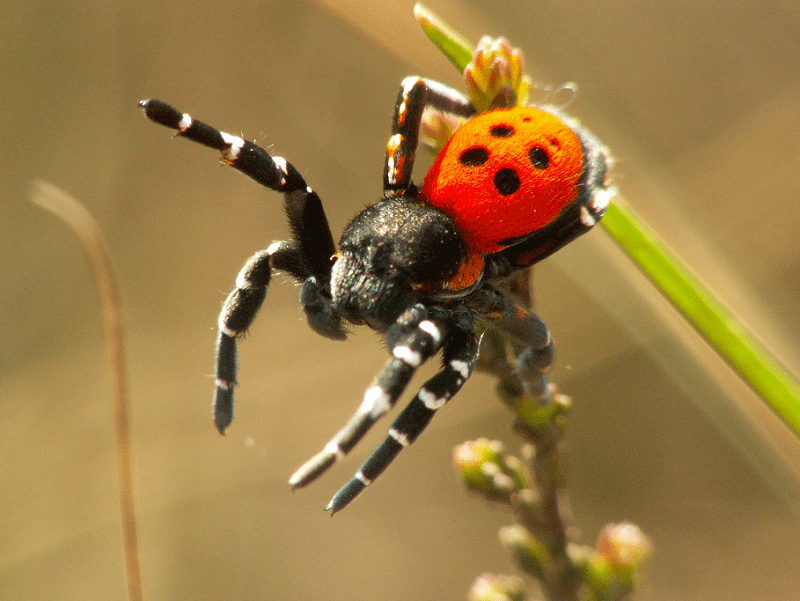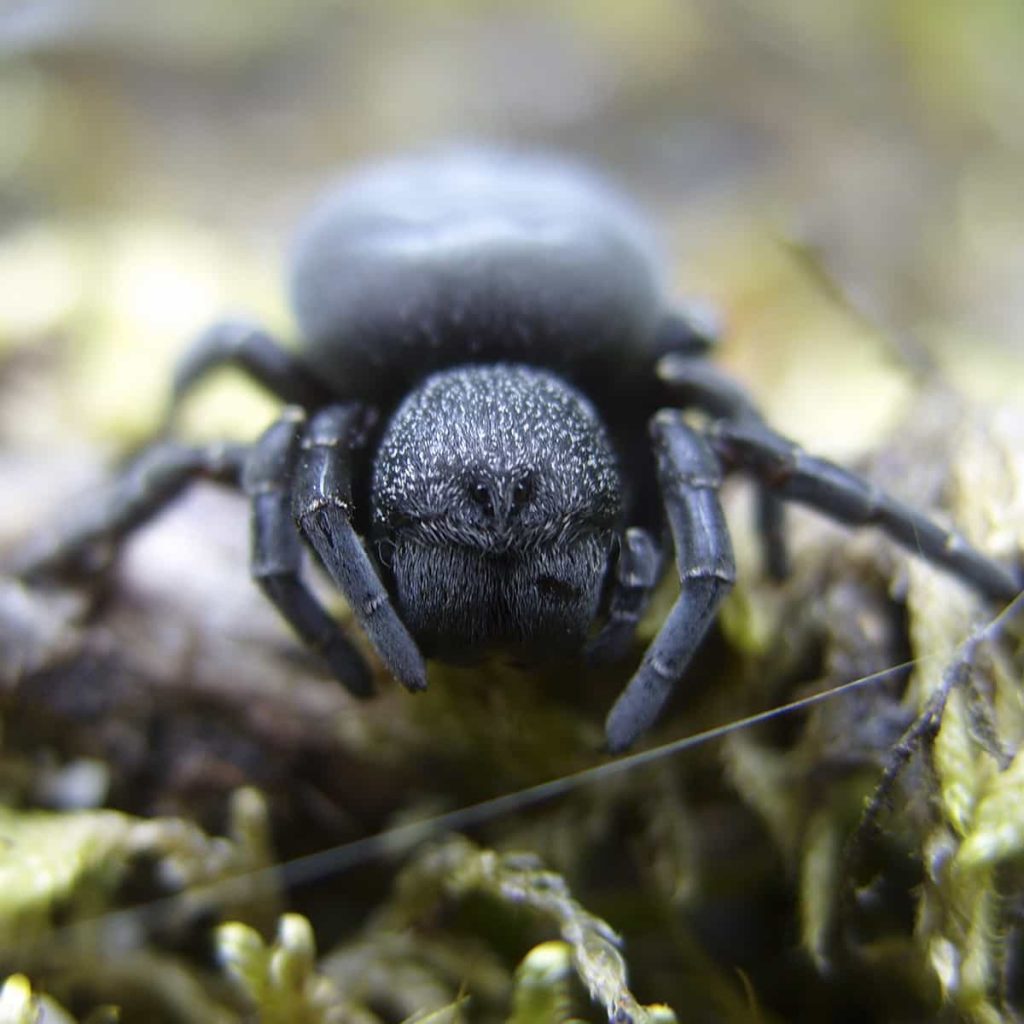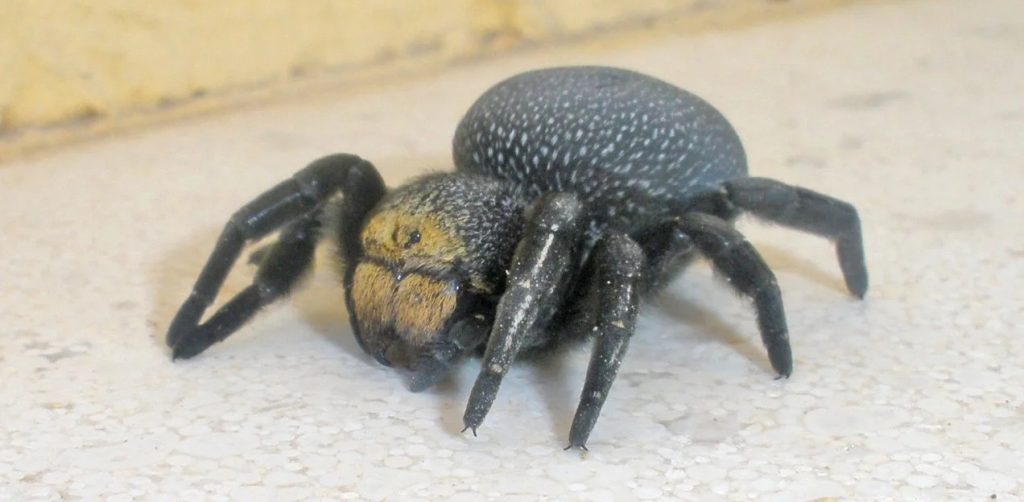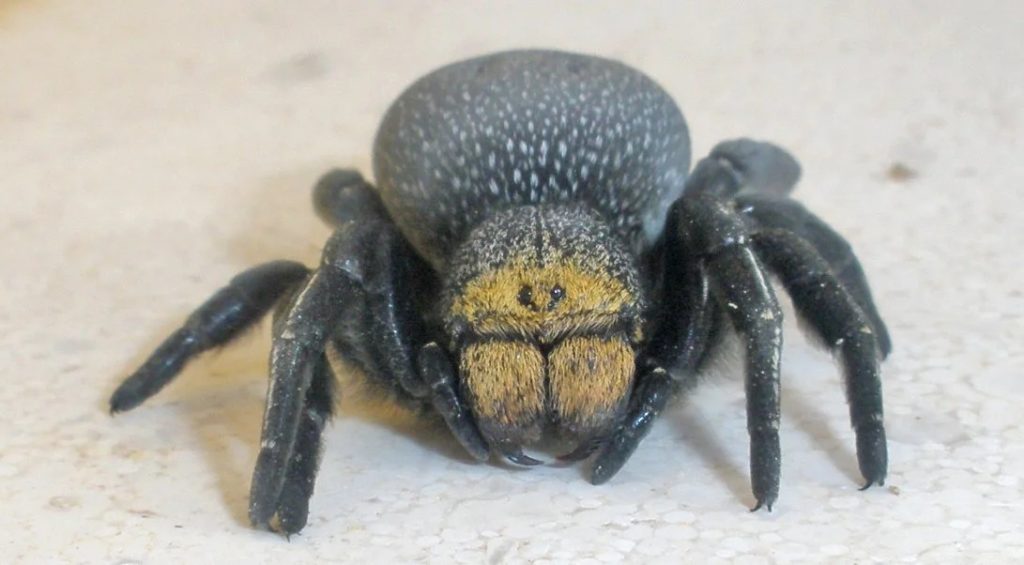Lady Bird Spider
Introduction:The Lady Bird Spider used to have the name of Eresus niger but nowadays it is called Eresus cinnaberinus. It is a member of the Erisidae family. This spider is very rare and is protected in some countries. The name “Lady Bird” comes from the appearance of the adult male seen in this picture. He only gets this colouring at his last change of skin.
Breeding:The Lady Bird Spider makes a single tube of silk on the ground and lays her eggs in a cocoon. In the day time, she brings out the cocoon to let it get warm and returns it to the tube at night.
Conclusion: The male spiders become adult in the Autumn or in the Spring and then start wandering about looking for mates. The female can stay in the tube for up to four years.The females are not as brightly coloured as the males.
Is the ladybird spider poisonous?
They are very toxic, harmless to humans, and generally not considered dangerous organisms. Ladybird spider typically exhibits biting behavior only as a defense mechanism.

Ladybird Spider Eresus sandaliatus
The Ladybird Spider is one of the UK’s rarest, and mostspectacular spiders. The Ladybird Spider was firstrecorded in Britain in 1816 (Leach 1816), howeverthere were only seven individuals recorded between1816 and 1906 in South Dorset. After 1906 it was notseen for decades, and thought to be extinct until it wasrediscovered in Dorset in 1979.The Ladybird Spider is a member of the Eresidae familyknown as ‘velvet’ spiders. The mature male, on his finalmoult, transforms into the charismatic form with astriking red abdomen with pairs of black spots andblack legs with hairs on the joints. This transformationis likely to be predator protection during his day timesearch for a female. Prior to this, the male’s appearanceis similar to the female and juveniles that are black withwhite stripes on their legs. The females can grow up to16mm, while the male are generally 10mm or less.Ladybird Spiders spend most of their lives in burrows inthe ground, which are vertical, silk-lined and crownedwith a canopy of silk.
What is a Ladybird Spider?
This is one of our most spectacular spiders, but also one of our most endangered, and it is at risk of extinction in the UK.
This colourful creature lives on lowland heathland, building vertical, silk-lined burrows, crowned with a silk canopy which they use to ambush the insects they feed on. Females and immature males are mostly black; the males develop that glorious red abdomen with black spots once they are ready to breed.

LifecycleMale Ladybird Spiders
reach maturity afterapproximately 3 years. Following their final moult asmature males, they emerge from their undergroundburrows around late April to early May on warm,sunny, calm days. The male spiders then go in search ofa mate. The males use chemical receptors on their frontlegs to detect pheromones that are released by maturefemales, secreted onto strand of silk on the canopy oftheir burrow. The female Ladybird Spider reachesmaturity after 4- 5 years, but may live much longer if amale spider has not found her yet.
After mating, the female Ladybird Spider lays up to 80eggs. She cares for the eggs by wrapping them in silk,her egg-cocoon measures up to 9mm long. She sealsherself and the eggs into a nursery chamber in herburrow. The female spider attaches the egg-cocoon tothe underneath of the web canopy moving it down intothe burrow if disturbed.After approximately one month, the spiderlings hatch,they spend most of their early life on or near theirmother in the burrow. The mother spider fills the insideof the burrow with silk threads that the youngspiderlings use to move around. The female LadybirdSpider then makes the ultimate sacrifice to give herspiderlings the best chance in life: she liquefies herinternal organs and regurgitates it to feed herspiderlings the nutritious fluid from her mouth.The mother dies after approximately two weeksfollowing the emergence of the spiderlings.The spiderlings build many silk tubes within the nurserychamber. Spiderlings emerge the following spring andbegin building their own burrows a short distance ornear to the maternal burrow.
Habitat
The Ladybird Spider depends on lowland heathland.They favour south-facing, sheltered slopes with welldrained sandy soil. In amongst the stones and heather,they build vertical silk-lined burrows crowned with acanopy of silk.
Distribution
Distribution: In the whole of the UK, Ladybird Spidersare only found in Dorset. The species also occurs inFrance, Belgium, The Netherlands, Denmark, Sweden,Germany, Czech Republic, Austria, Greece and Turkey.
Protection under the law
This spider is included as a species “of principalimportance for the purpose of conserving biodiversity”under Section 41 (England) of the Natural Environmentand Rural Communities Act 2006.The Ladybird Spider is protected under the Wildlife andCountryside Act 1981, Schedule 5 Section 9.1(intentional killing or injuring, taking/removing), 9.2(possession or controlling -alive or dead), 9.4a(intentional damage or destruction) 9.4b (intentionaldisturbance) & 9.5a (being sold, offering for sale orbeing transported or held for sale -alive or dead or anypart) 9.5b (being published or advertised as being forsale)
Survey method
Due to the spider’s conservation status and legalprotection only a licensed individual may survey for thisspider. It is against the law to disturb the spiders in anyway, for example by taking photographs.

Reasons for decline
Dramatic loss and damage to heathland habitat due toagriculture, forestry, development and other land-usechanges, coupled with the spiders’ very specificrequirements, all increase the vulnerability of theLadybird spider to extinction.
Ladybird Spider Distribution, Habitat, and Ecology
First of all, the remarkable Ladybird Spider continues to be endemic to a restricted range across Europe. This range extends from England and southern Norway, all the way to northern Italy. But, within that area, these spiders typically prefer a highly specialized habitat. It also seems to favor inhabiting areas of lowland heath. Most relevantly, within that habitat type, it favors south-facing slopes, with well-drained soil almost exclusively. Consequently, it constructs its nests there, which consists of vertical burrows lined with silk, with a crown of spider silk. These it uses to catch the wide variety of insects they prey upon.
Special, Spotty and Not Very Spooky!
Spiders are supposed to be spooky and scary, right? Well, we think the little ladybird spider looks more cute than creepy. You’re very unlikely to spot this spotty species in the wild, though. In fact, no one had seen a ladybird spider in the UK for so long that scientists decided it must be extinct – but then it was rediscovered! People are now working hard to protect this amazing arachnid.

What’s with the spots?
Ladybird spiders aren’t actually related to ladybirds; they’re named after them because of the male spider’s bright red, spotty body. The four big, black dots on its back are arranged in a pattern just like a four on a die! Arachnologists (people who study spiders) believe this eye-catching design is a warning to possible predators. Male ladybird spiders are mini – about the same size as a ladybird (less than 1cm long). Females are a bit bigger (about 1.5cm) and black all over.
Why are they so hard to spot?
Ladybird spiders live in long, tunnel-like burrows. Females spend their whole lives in these underground homes. Males only come to the surface to search for a mate. After mating, the female lays around 50 eggs in her burrow. Once they’ve hatched, the baby spiderlings are looked after by their mum in a nursery web until she dies about a month later. By the next spring, they are old enough to leave home and make a burrow for themselves. But they don’t go far – young spiders only move about a metre (at most) from where they were born!
Where do they live?
Ladybird spiders live in north and central Europe, but they are really rare. In the UK, they are only found in Dorset, in the south-west of England. The heathland there provides the perfect habitat for them. But that also creates a problem. Lots of the UK’s heathland has been destroyed over the last 100 years – most of it has been built on or turned into land for farming and forestry. As the amount of heathland has decreased, so too has the number of ladybird spiders. For much of the 20th century, people thought that ladybird spiders had died out completely in the UK. Then, in 1980, a single population of just a few spiders was found.
